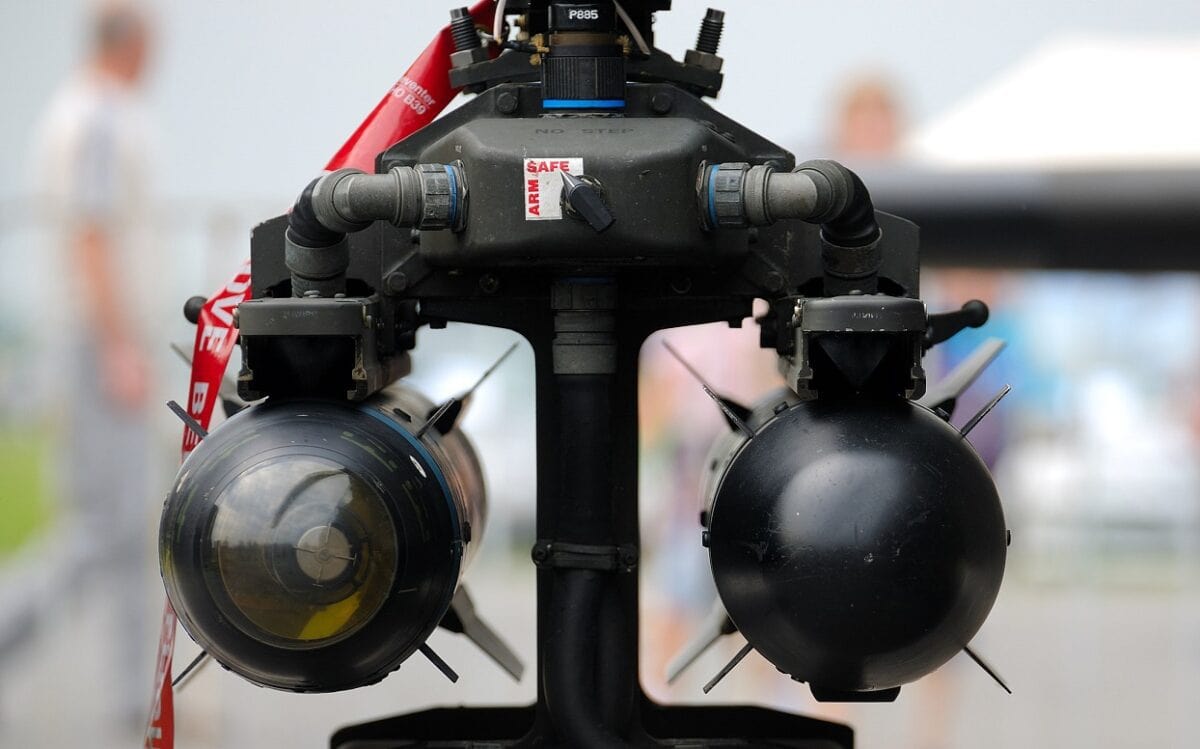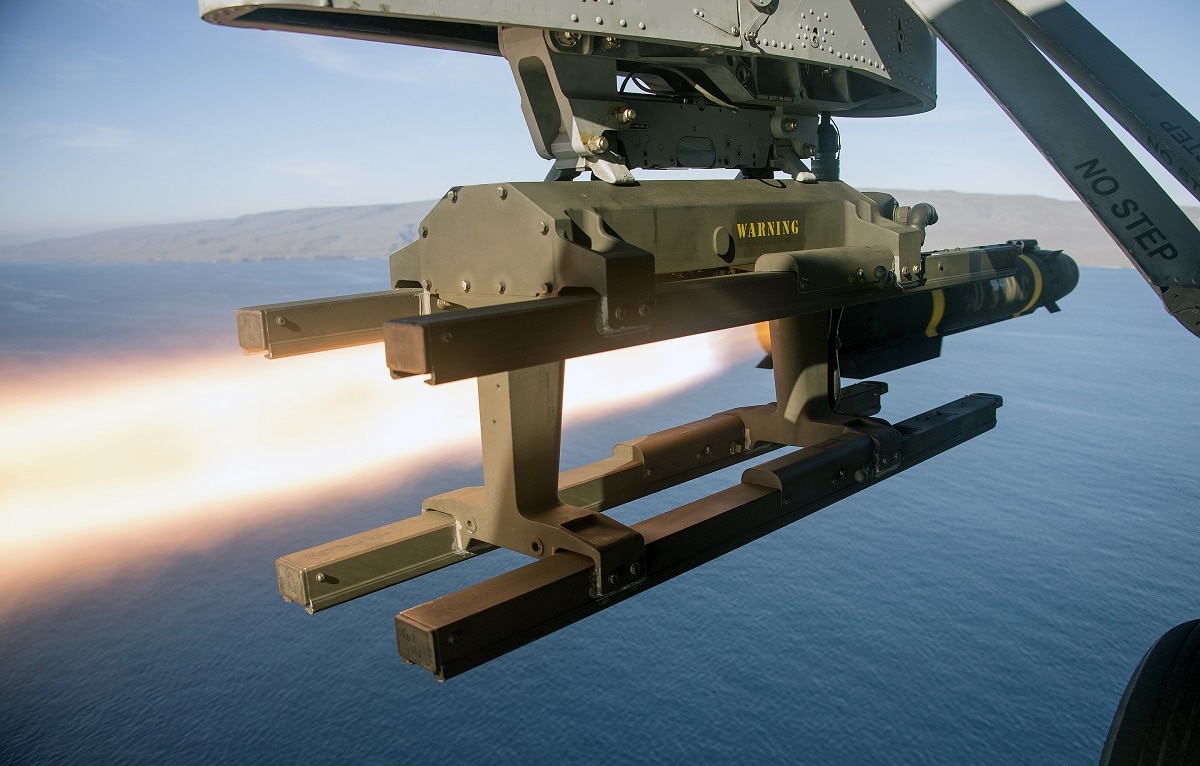The phrase “hellfire and brimstone” means different things to different people, depending on the context. In a religious context, it refers to the threat of eternal damnation and suffering after death as punishment for living a sinful life.
In a more secular context, old-school WWE fans will be reminded of Hall of Fame announcer Jim “J.R.” Ross using the phrase while announcing the ring entrance of behemoth wrestler Kane, AKA “The Big Red Machine.”
In the military context,“Hellfire” and “Brimstone” are the names of two different air-to-surface missiles. Since this writer has already written an article on the Brimstone, it is now time to give the AGM-114 Hellfire missile its moment in the sun.
Hellfire Early History and Specifications
The AGM-114 Hellfire missile began development in 1974 and officially entered into U.S. Army service in 1986, followed by the Hellfire II modular version in 1996. “AGM” is an acronym for “air-to-ground missile,” and believe it or not, “Hellfire” started off as an acronym as well. As my colleague Maya Carlin notes, “The designation Hellfire comes from the missile’s original title HELFIRE or ‘HELiborne Laser FIRE and Forget Missile.’” It was specifically designed as a tank-buster.
The Hellfire is currently manufactured by Lockheed Martin. The company proudly proclaims the product’s “proven position as the world’s premier multi-purpose air-to-ground weapon system.” That same press release lists three variants of the missile: “the high- explosive anti-tank (HEAT) missile (AGM-114K), used against armored targets; the blast fragmentation missile (AGM-114M), effective against ships, caves, light armored vehicles, buildings, bunkers and other urban targets; and the metal augmented charge (MAC) missile (AGM-114N), which provides an enhanced blast fragmentation effect against enclosed structures and enemy personnel.”
The weapon relies on semi-active laser homing and a millimeter-wave radar seeker for its accuracy. Specifications include a weight of 108 pounds, a length of 64 inches, a diameter of 7 inches, and a wingspan of 13 inches, Operational range is from 550 to 12,030 yards, with a maximum speed of 995 miles per hour (Mach 1.3).
Battle-Proven With the U.S. Army…
The best-known and most battle-proven launching platform for the Hellfire missile is the AH-64 Apache helicopter gunship, whose manufacturer Boeing describes as “the world’s most advanced and proven attack helicopter.” The effectiveness of the Apache-Hellfire tandem was first displayed during Operation Just Cause in Panama in December 1989. The whirlybirds and their accompanying missiles provided highly accurate fire support for an assault on the Comandancia building of Panamanian strongman Manuel Noriega’s Panamanian Defense Forces. Then-USSOCOM Commander Gen. Carl W. Stiner was quoted as saying “You could fire that Hellfire missile through a window four miles away at night.”
The Apaches and Hellfires attained even greater glory and notoriety during the 1991 Persian Gulf War, AKA Operation Desert Storm. For starters, they fired the first shots of that campaign, knocking out two key early-warning radar installations in western Iraq at 2:38 a.m. on Jan. 17, 1991. From there, they went on to destroy more than 500 of Iraqi dictator Saddam Hussein’s main battle tanks.
…And the Iraqi Air Force
But the Hellfire isn’t just meant for choppers. It is also quite adept as armament for fixed-wing combat aircraft, and against myriad ground targets, not just tanks. As I can attest from personal experience and my observations as an overseas private military contractor, the Hellfire’s utility and effectiveness in this regard was demonstrated by the Iraqi Air Force (IqAF).
My final Iraq contract was spent at Balad air base from April 2015 to December 2018, providing training & mentorship to the IqAF in the heady days of their fight against the Islamic State. During my first few months in-country, while the IqAF was waiting for its long-awaited F-16 Fighting Falcons to be certified for arrival, its courageous aircrews were using the propeller-driven AC-208 Combat Caravan light attack aircraft — which is a militarized version of the highly popular Cessna 208 Grand Caravan civilian leisure plane — to take the fight to the ISIS terrorists. Even after the F-16s arrived at Balad, the Combat Caravans continued to contribute heavily to the anti-ISIS campaign. Their subsonic speed and lower rates of fuel compensation gave the Cessna crews an extra loitering capability that the high-tech F-16s didn’t have.
The IqAF Combat Caravans’ weapon of choice? Yep, you guessed it: the Hellfire missile, mounted on underwing hardpoints. Though I didn’t have the honor and privilege of actually accompanying the Iraqi Caravan drivers on any of their missions, I got to see them take off and land regularly. I also remember seeing an IqAF info sheet extolling the virtues of the Hellfire that was posted in the base defense operations center where I worked as a shift supervisor.

Hellfire Missile. Image Credit: Creative Commons.
Suffice to say that the Iraqi Caravan crews used their Hellfires with telling effect and killed a lot of ISIS bad guys with them. Tragically, in turn the good guys suffered at least one Caravan lost on a combat mission in March 2016, with the entire crew killed in action. One of the KIAs was a personal friend of mine, Amid (Brigadier General) Ali.
You can see a brief clip of an IqAF AC-208 launching a Hellfire missile at the 3:43 mark of the official YouTube video for the Iraqi military motivational song “Ya-Sattar” performed by pop singer Ahmed Jawad.
Christian D. Orr is a former Air Force Security Forces officer, Federal law enforcement officer, and private military contractor (with assignments worked in Iraq, the United Arab Emirates, Kosovo, Japan, Germany, and the Pentagon). Chris holds a B.A. in International Relations from the University of Southern California (USC) and an M.A. in Intelligence Studies (concentration in Terrorism Studies) from American Military University (AMU). He has also been published in The Daily Torch and The Journal of Intelligence and Cyber Security. Last but not least, he is a Companion of the Order of the Naval Order of the United States (NOUS).

